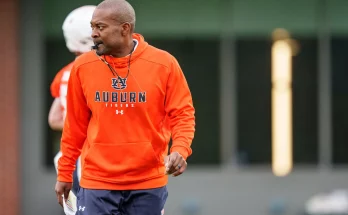Ohio State QB Julian Sayin Says No to Texas and Alabama — The Longhorns and Tide Miss Out on This Top Signal-Caller
Julian Sayin, one of the brightest quarterback prospects in the country, just made waves in the college football recruiting world by turning down two of the sport’s biggest programs: the Texas Longhorns and the Alabama Crimson Tide. This decision sent shockwaves through fan bases and recruiting insiders alike, as both schools had aggressively pursued the talented passer for months. Sayin’s choice reflects not only his confidence in himself but also a shifting landscape in college football recruiting, where players are increasingly taking control of their futures and prioritizing fit, development, and opportunity over traditional powerhouse prestige.
Sayin’s story is that of a highly sought-after quarterback with a polished skill set and a football IQ well beyond his years. From the moment he emerged on the national radar, offers from blue-blood programs flooded in. Texas and Alabama stood out as natural fits—both historically dominant teams with rich quarterback traditions and the resources to develop elite talent. Yet, despite their allure, Sayin made a clear statement: he won’t just take the flashiest offer or the most famous jersey. He’s carving his own path, and that path doesn’t include the Longhorns or the Tide.
This move highlights how the recruiting game has evolved. Gone are the days when a handful of programs could lock down the nation’s top prospects simply by virtue of their brand. Today’s elite players weigh a multitude of factors: offensive schemes, coaching styles, depth charts, development pipelines, academic fit, campus culture, and even proximity to home. They have agents, advisors, and media platforms amplifying their voices, giving them unprecedented agency. Sayin’s rejection of Texas and Alabama underscores this dynamic—he’s evaluating what will best serve his personal and athletic growth rather than following the conventional wisdom of chasing prestige alone.
While the exact reasons behind Sayin’s decision remain his own, several educated guesses can be made based on recent trends and comments from his camp. First, the competition at quarterback for both Texas and Alabama remains fierce. Each program boasts multiple talented quarterbacks vying for playing time, and breaking through as a freshman or sophomore isn’t guaranteed. For a player of Sayin’s caliber, securing the opportunity to start or meaningfully contribute early is a huge factor. If other programs present a clearer path to the field, it makes perfect sense for him to lean that way.
Second, offensive philosophy plays a massive role in quarterback recruiting today. Players want to fit into schemes that maximize their strengths and develop their versatility. The spread, RPO-heavy offenses and mobile quarterback designs have grown increasingly popular, and Sayin’s style of play likely influences where he wants to land. Texas and Alabama, while elite programs, have evolved their offenses differently under recent coaching changes. Sayin’s decision suggests that he’s looking for a system that perfectly suits his skill set—one that might not align fully with either of these programs at this time.
Another consideration could be the coaching staffs themselves. Coaches are not just tacticians; they are mentors, developers, and recruiters who must build trust and chemistry with their players. A strong relationship between Sayin and the coaching staff at a different school could have tipped the scales. Likewise, changes in personnel or uncertainty in the staffs at Texas or Alabama might have raised red flags. Stability and personal connection are vital when young athletes entrust coaches with their future.
For Alabama and Texas fans, this news stings. Both schools have invested heavily in recruiting Sayin and saw him as a potential cornerstone to maintain or elevate their programs. Alabama, fresh off national championship contention and with a storied quarterback lineage, likely viewed Sayin as a prime candidate to continue that tradition. Texas, a program on the rise with high-profile transfers and a new coaching regime, also envisioned Sayin as a key piece in their quest to return to national prominence. Losing out on such a prized recruit sends a reminder that no program is untouchable in today’s recruitment wars.
However, this setback also reflects the highly competitive nature of college recruiting today. Coaches across the country are vying for the same elite players, and margins are razor-thin. One missed connection, a poor timing on a call, or a slightly weaker relationship can swing a recruit’s allegiance. It’s a reminder that recruiting is as much about people and fit as it is about prestige and tradition. Both Alabama and Texas will now have to pivot, recalibrate, and pursue other targets to fill their quarterback rooms.
For Sayin, the spotlight now intensifies on his next move. With two of the biggest programs officially turned down, all eyes turn to where he will commit. The recruiting community buzzes with speculation—will he choose a program with a strong quarterback development track record, a less crowded depth chart, or a unique scheme that amplifies his talents? The answer will reveal much about the changing calculus of elite recruits and the shifting power dynamics in college football.
One of the biggest winners in this scenario is the player himself. Sayin’s ability to say no to programs like Alabama and Texas shows remarkable confidence and a willingness to think long-term. Rather than rushing into the most headline-grabbing commitment, he’s playing the long game, betting on himself and the program that offers him the best chance to thrive. That mentality often separates good players from great ones. It’s also a reminder to fans and analysts that recruiting is ultimately about fit and development—not just names on jerseys.
This situation also highlights the evolving recruiting landscape where NIL (Name, Image, Likeness) opportunities play a role. Elite recruits like Sayin now consider how a school’s location, market, and media exposure can impact their off-field earning potential. While Alabama and Texas are in major media markets, other schools might offer more focused marketing opportunities or local endorsements that better fit Sayin’s personal brand ambitions.
In addition, family and personal considerations often weigh heavily. Proximity to home or comfort with campus culture can sway decisions more than outsiders realize. Sayin’s choice reflects not just a football decision but a life decision—a place where he feels he can grow not only as a player but as a person.
In the end, this development isn’t just about a recruit saying no to two powerhouse programs. It’s about the empowerment of young athletes to chart their own courses, weigh their options carefully, and prioritize their futures on their own terms. It’s a sign of a maturing recruiting process where players are not just prospects to be won but individuals with unique needs and visions.
As the recruiting cycle continues, all eyes will remain on Julian Sayin. The quarterback who dared to turn down Texas and Alabama has set the bar for self-determination. Whichever program lands him will have earned more than a commitment—they will have gained a player who knows his worth and refuses to settle. For everyone else, it’s a lesson in respect and the new realities of recruiting in the modern era.
Julian Sayin’s story is just beginning, but his impact on the recruiting world is already unmistakable. He’s a player, a leader, and now, a trendsetter. As the clock ticks toward National Signing Day, the question remains: who will be the next to see the promise of this talented quarterback and win his trust? One thing is for certain—this isn’t the last time Sayin’s decisions will ripple through college football.



